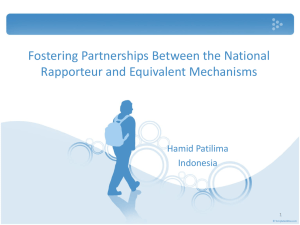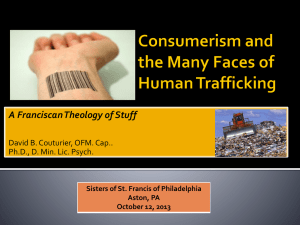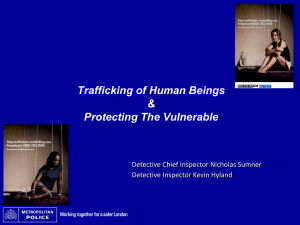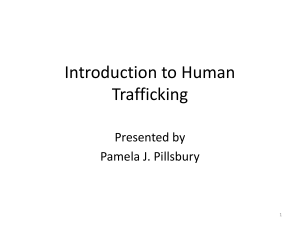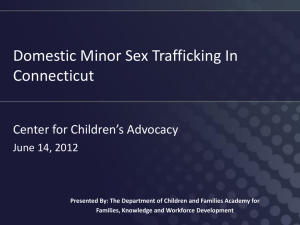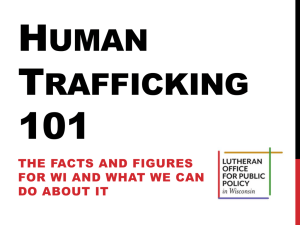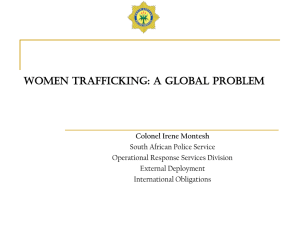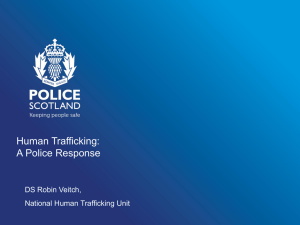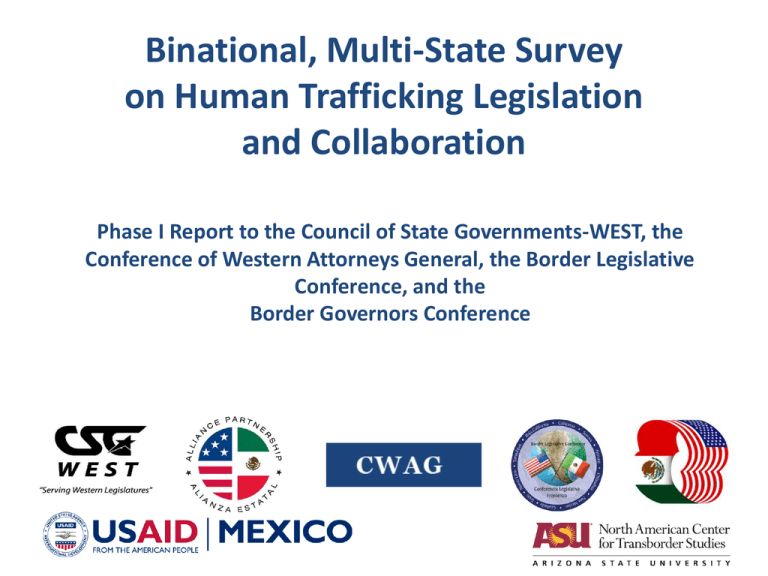
Binational, Multi-State Survey
on Human Trafficking Legislation
and Collaboration
Phase I Report to the Council of State Governments-WEST, the
Conference of Western Attorneys General, the Border Legislative
Conference, and the
Border Governors Conference
Research Team
Principal Investigator/Project Lead
Erik Lee, Associate Director, NACTS/ASU
Research Team
• Jonathan Alanis, NACTS Undergraduate Policy Research Assistant,
Political Science, ASU
• Felicia Cantrell, Second-year law student, Sandra Day O’Connor
School of Law, ASU
• Zoe Sarabo, Masters Program in Liberal Studies, ASU
Project Advisors/Consultants
• Gabriella Sánchez, PhD, Justice Studies, School of Social
Transformation, ASU
• Rick Van Schoik, Director, North American Center for Transborder
Studies, ASU
Overview of NACTS
• Trinational, Multidisciplinary, Public Policy Analysis
and Advisory Group
• 7 Partner Universities + Board of Advisors
• Three Foci: Sustainability, Security,
Competitiveness
• Member of Border Research Partnership
• “North America Next: A Report to President
Obama on Building Sustainable Security,” February
2009
• “CANAMEX Economic Profile,” 2008-2010
• “North American Opportunities and the Sun
Corridor,” November 2009
• “Assessing Scrap Tire Legislation in the U.S.Mexico Border States,” November 2009, Border
Legislative Conference
We work for you and with you!
Some General Comments
• This report was requested by the BLC, CWAG and the
BGC and will be updated fairly regularly.
• This is a significant policy priority for both countries
federal governments and many states and therefore a
good area around which to build collaboration.
• Large and active communities of interest exist on this
topic in both countries.
• In particular, the amount of activity in Mexico on this
issue is impressive (and a challenge for researchers).
• Precise statistics on the issue of human trafficking are a
work in progress.
• Much of this legislation, particularly in Mexico, is quite
recent.
Initial Findings
• U.S. state legislation is quite diverse.
– Key elements vary from specific focus on trafficking
(borrowing some federal language), victim assistance
funds, to basic legislative approaches such as
“compelling prostitution.”
• Mexican legislation is quite uniform.
– All six Mexican border states have a law (or are about
to have one) on human trafficking.
– Focuses on elements such as more precise definitions
of trafficking and state intersecretarial committees.
– Broader context includes the Mexican government’s
fight against transnational criminal organizations and
the shift to oral adversarial systems of justice by 2016.
U.S. Overview
Conference of Western Attorneys General (CWAG)
Member and Associate Member States
Federal…and very local
• Federal legislation: Trafficking Victims Protection
Act of 2000
• Presidential Task Force led by Department of
State
• 40 metro-area anti-trafficking task forces
coordinated by U.S. Attorneys offices working
with ICE, DOL, local PD’s, NGOs etc.
• County attorneys also pursue trafficking cases….
although NM AG’s Office also pursues cases
• Few prosecutions so far.
The CWAG States: Lots of Variety
• The U.S. states’ laws range from specific
human trafficking legislation to related laws
such as pandering (examples).
• Some states have been actively updating their
trafficking legislation.
• New Mexico has recently adopted a new
human trafficking statute and the state of
Washington recently updated its laws in 2010.
• Some states have victim assistance funds.
The Mexican Border States
Mexico Federal Overview
• Federal legislation: 2007 Law to Prevent and
Sanction Human Trafficking (some states such as
Chihuahua or Coahuila have been working on the
topic since 2006)
• Federal interagency task force (Comisión
Intersecretarial)
• Federal inter-agency task force are mandated to
come out with a plan to prevent and sanction
human traffic
• Mexico’s national plan on human trafficking was
officially announced on January 6, 2011.
The Mexican Border States:
“Let’s Stay on the Same Page”
• Mexican border states’ anti-human trafficking
laws are notable for their uniformity (role of
USAID-funded PROTEJA).
• The ongoing homogenization of state laws is a
specific and widely supported policy objective in
Mexico.
• Similar to Mexico’s federal legislation, Mexican
state human trafficking laws mandate the
creation of interagency task forces and in some
cases specifically encourage agencies to
collaborate.
Substantive Recommendations
1.
2.
3.
4.
Consider legislation that incentivizes and funds productive
interstate, binational and international collaboration on statutory
language and state law enforcement agency collaboration to
address both domestic and cross-border aspects of human
trafficking in a proactive manner (CWAG and BLC).
Consider legislative approaches that adequately fund programs
that train state and local law enforcement officials in the
recognition and prevention of human trafficking (CWAG and BLC).
Consider legislative approaches that take a victim-centered
approach and prioritize comprehensive approaches to victims of
both sex trafficking and labor trafficking through mechanisms such
as victims assistance funds (CWAG and BLC).
U.S. states should strongly consider adopting the language of the
Trafficking Victims Protection Act of 2000 to aid in building a more
comprehensive approach at the state level (CWAG and BLC).
Organizational, Process and
Collaboration Recommendations
1.
2.
3.
Create a permanent binational policy review committee made up of
representatives from the U.S.-Mexico State Alliance Partnership member
organizations, the Border Governors Conference Security Work Table,
state and county prosecutors, and the relevant federal agencies.
Conduct regular U.S.-Mexico State Alliance Partnership visits and
publication of findings with key U.S. and Mexican border state
legislatures’ commissions to discuss human trafficking legislation and a
broad range of policy implementation in the U.S.-Mexico border region,
with a focus on best practices on issues such as attention to victims and
coordination (CWAG and BLC).
Develop partnerships with key Mexican academic and policy
organizations to further research and evaluate human trafficking,
measures taken to address both the crime and victims of trafficking in
Mexico (BGC, BLC and CWAG).
Organizational, Process and Collaboration
Recommendations (cont.)
4. Discuss and adopt key medium- and long-term measures
that evaluate legislative success on the issue of human
trafficking and attention to victims of both sex trafficking
and labor trafficking in the U.S. and Mexico (BLC).
5. Develop or link to innovative programs to recognize state
legislatures and legislators for innovative and best
legislative practices to combat human trafficking (BLC).
6. Enable CWAG to offer binational trainings and best
practice development on handling human trafficking cases
in partnership with key Mexican government and civil
society stakeholders as part of its trainings for Mexican
judges, prosecutors, forensic workers and police (CWAG).
Directions and Ideas for Phase II
• State outreach.
• Federal outreach.
• More emphasis on policy areas victim
attention and implementation of state and
federal plans (in Mexico).
• ?
Thank you!
For more information on this project:
Erik Lee
Associate Director
North American Center
for Transborder Studies
Arizona State University
Tel. (480) 727-8926
erik.w.lee@asu.edu
Website: nacts.asu.edu


